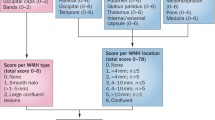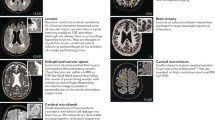Abstract
The neuroanatomical substrate of vascular cognitive impairment (VCI) has traditionally included the subcortex of the brain, especially sub-frontal white matter circuits, strategic areas of single infarction that may mediate cognitive impairment such as the dominant thalamus or angular gyrus, and the left hemisphere, and bilateral brain infarcts or volume-driven cortical-subcortical infarctions reaching a critical threshold of tissue loss or injury. We provide an update on the neuroanatomical substrates of VCI and emphasize the following structures or areas: (1) new concepts in relation to hippocampal involvement in VCI based on neuropathological and MRI studies of microinfarcts and the role of traditional cardiovascular risk factors in possibly mediating or potentiating cognitive impairment; (2) advances in our understanding of cerebral microbleeds; and (3) an update on white matter hyperintensities and small vessel disease.
Similar content being viewed by others
References
Papers of particular interest, published recently, have been highlighted as: • Of importance •• Of major importance
Hachinski V. Vascular dementia: a radical redefinition. Dementia. 1994;5:130–2.
Wetterling T, Kanitz RD, Borgis KJ. The ICD-10 criteria of vascular dementia. Dementia. 1994;5:185–8.
Erkinjuntti T. Clinical criteria for vascular dementia: the NINDS-AIREN Criteria. Dementia. 1994;5:189–92.
•• Gorelick PB, Scuteri A, Black SE, et al. Vascular contributions to cognitive impairment and dementia: a statement for healthcare professionals from the American Heart Association/American Stroke Association. Stroke. 2011;42:2672–713. It is a guidance paper on vascular contributions to cognitive impairment.
O’Brien MD. How does cerebrovascular disease cause dementia? Dementia. 1994;5:133–6.
Gorelick PB. Status of risk factors for dementia associated with stroke. Stroke. 1997;28:459–63.
Tomlinson BE, Blessed G, Roth M. Observations of the brains of demented old people. J Neurol Sci. 1970;11:205–42.
Pantoni L. Cerebral small vessel disease: from pathogenesis and clinical characteristics to therapeutic challenges. Lancet Neurol. 2010;9:689–701.
Mori E. Functional brain imaging. In: Erkinjuntti T, Gauthier S, editors. Vascular cognitive impairment. London: Martin Dunitz Ltd; 2002. p. 417–31.
DeCarli C, Scheltens P. Structural brain imaging. In: Erkinjuntti T, Gauthier S, editors. Vascular cognitive impairment. London: Martin Dunitz Ltd; 2002. p. 433–57.
Stebbins GT, Nyenhuis DL, Wang C, et al. Gray matter atrophy in patients with ischemic stroke with cognitive impairment. Stroke. 2008;39:785–93.
Gorelick PB, Bowler JV. Advances in vascular cognitive impairment 2007. Stroke. 2008;39:279–82.
Gorelick PB, Bowler JV. Advances in vascular cognitive impairment. Stroke. 2010;41:e93–8.
Debette S, Seshadri S, Beiser A, et al. Midlife vascular risk factor exposure accelerates structural brain aging and cognitive decline. Neurology. 2011;77:461–8.
Viswanathan A, Greenberg SM. Cerebral amyloid angiopathy in the elderly. Ann Neurol. 2011;70:871–80.
• Ballard C, Gauthier S, Corbett A, et al. Alzheimer’s disease. Lancet. 2011;377:1019–31. This is instrumental in revising the definition of VAD.
Mayeux R. Early Alzheimer’s disease. N Engl J Med. 2010;362:2194–201.
Szabo K, Forster A, Jager T, et al. Hippocampal lesion patterns in acute posterior cerebral artery stroke. Clinical and MRI findings. Stroke. 2009;40:2042–5.
Stephens RG, Stilwell KL. Arteries and veins of the human brain. Springfield: Charles C. Thomas; 1969.
Wu W, Brickman AM, Luchsinger J, et al. The brain in the age of old: the hippocampal formation is targeted differentially by diseases of late life. Ann Neurol. 2008;64:698–706.
Craft S. The role of metabolic disorders in Alzheimer disease and vascular dementia. Arch Neurol. 2009;66:300–5.
Blum S, Luchsinger JA, Manly JJ, et al. Memory after silent stroke. Hippocampus and infarcts both matter. Neurology. 2012;78:38–46.
Arvanitakis Z, Leurgans S, Barnes LL, et al. Microinfarct pathology, dementia, and cognitive systems. Stroke. 2011;42:722–7.
Launer LJ, Hughes TM, White LR. Microinfarcts, brain atrophy, and cognitive function: the Honolulu Asia Aging study Autopsy study. Ann Neurol. 2011;70:774–80.
Gemmell E, Bosomworth H, Allan L, et al. Hippocampal neuronal atrophy and cognitive function in delayed poststroke and aging-related dementias. Stroke. 2012;43:808–14.
Kantarci K, Senjem ML, Avula R, et al. Diffusion tensor imaging and cognitive function in older adults with no dementia. Neurology. 2011;77:26–34.
Knopman DS, Penman AD, Catellier DJ, et al. Vascular risk factors and longitudinal changes on brain MRI. The ARIC study. Neurology. 2011;76:1879–85.
Greenberg SM, Vernooij MW, Cordonnier C, et al. Cerebral microbleeds: a guide to detection and interpretation. Lancet Neurol. 2009;8:165–74.
Fazekas F, Kleinert R, Roob G, et al. Histopathologic analysis of foci of signal loss on gradient-echo T2*-weighted MR images in patients with spontaneous intracerebral hemorrhage: evidence of microangiopathy-related microbleeds. Am J Neuroradiol. 1999;20:637–42.
Poels MF, Meike VW, Ikram A, et al. Prevalence and risk factors of cerebral microbleeds. An update of the Rotterdam Scan study. Stroke. 2010;41:S103–6.
Vernooij MW, van der Lugt A, Ikram MA, et al. Prevalence and risk factors of cerebral microbleeds: the Rotterdam scan study. Neurology. 2008;70(14):1208–14.
Gregoire SM, Brown MM, Kallis C, et al. MRI detection of new microbleeds in patients with ischemic stroke: five-year cohort follow-up study. Stroke. 2010;41:184–6.
Chodhury MH, Nagai A, Bokura H, et al. Age-related changes in white matter lesions, hippocampal atrophy, and cerebral microbleeds in healthy subjects without major cerebrovascular risk factors. J Stroke Cerebrovasc Dis. 2011;20(4):203–309.
Arvanitakis Z, Leurgans SE, Wang Z, et al. Cerebral amyloid angiopathy pathology and cognitive domains in older persons. Ann Neurol. 2011;69:320–7.
Gregoire SM, Smith K, Jager HR, et al. Cerebral microbleeds and long-term cognitive outcome: longitudinal cohort study of stroke clinic patients. Cerebrovasc Dis. 2012;33:430–5.
Tang WK, Chen Y, Lu J, et al. Absence of cerebral microbleeds predicts reversion of vascular ‘cognitive impairment no dementia’ in stroke. Int J Stroke. 2011;6:498–505.
van Norden AGW, van den Berg HAC, de Laat KF, et al. Frontal and temporal microbleeds are related to cognitive function. The Radboud University Nijemegen Diffusion Tensor and Magnetic Resonance Cohort (RUN DMC) study. Stroke. 2011;42:3382–6.
van Es ACGM, van der Grond J, de Craen AJM, et al. Cerebral microbleeds and cognitive functioning in the PROSPER study. Neurology. 2011;77:1446–52.
Qui C, Corch MF, Sigurdsson S, et al. Cerebral microbleeds, retinopathy, and dementia. The AGES-Reykjavik study. Neurology. 2010;75:2221–8.
Poels MMF, Ikram MA, van der Lugt A, et al. Cerebral microbleeds are associated with worse cognitive function. The Rotterdam Scan study. Neurology. 2012;78:326–33.
Wardlaw JM, Bastin ME, Hernandez V, et al. Brain aging, cognition in youth and old age and vascular disease in the Lothian Birth Cohort 1936: rationale, design and methodology of the imaging protocol. Int J Stroke. 2011;6:547–59.
Oxford Project to Investigate Memory and Ageing (OPTIMA) cohort. Cerebral subcortical small vessel disease and its relation to cognition in elderly subjects: a pathological study in the Oxford Project to Investigate Memory and Ageing (OPTIMA) cohort. Neuropathol Appl Neurobiol. 2012;38:337–43.
Koga H, Takashima Y, Murakawa R, et al. Cognitive consequences of multiple lacunes and leukoaraiosis as vascular cognitive impairment in community-dwelling elderly individuals. J Stroke Cerebrovasc Dis. 2009;18:32–7.
Pantoni L. 2001-2011: a decade of the LADIS (Leukoaraiosis and Disability) study: what have we learned about white matter changes and small-vessel disease? A LADIS Study Goup. Cerebrovasc Dis. 2011;32:577–88.
Benistry S, Gouw AA, Prcher R, et al. Location of lacunar infarcts correlates with cognition in a sample of non-disabled subjects with age related white-matter changes: the LADIS study. J Neurol Neuosurg Psychiatry. 2009;80:478–83.
Jokinen H, Kalska H, Ylikoski R, et al. Longitudinal cognitive decline in subcortical ischemia vascular disease. The LADIS study. Cerebrovasc Dis. 2009;27:384–91.
Verdelho A, Madureira S, Moleiro C, et al. White matter changes and diabetes predict cognitive decline in the elderly. The LADIS study. 2010;75:160–7.
Inaba M, White L, Bell C, et al. White matter lesions on brain magnetic resonance imaging scan and 5-year cognitive decline: the Honolulu-Asia Aging study. J Am Ceriatr Soc. 2011;59:1484–9.
Haan M, Espeland MA, Klein BE, et al. Cognitive function and retinal and ischemic brain changes. The women’s health initiative. Neurology. 2012;78:942–9.
Disclosure
No potential conflicts of interest relevant to this article were reported.
Author information
Authors and Affiliations
Corresponding author
Rights and permissions
About this article
Cite this article
Grysiewicz, R., Gorelick, P.B. Key Neuroanatomical Structures for Post-Stroke Cognitive Impairment. Curr Neurol Neurosci Rep 12, 703–708 (2012). https://doi.org/10.1007/s11910-012-0315-2
Published:
Issue Date:
DOI: https://doi.org/10.1007/s11910-012-0315-2




